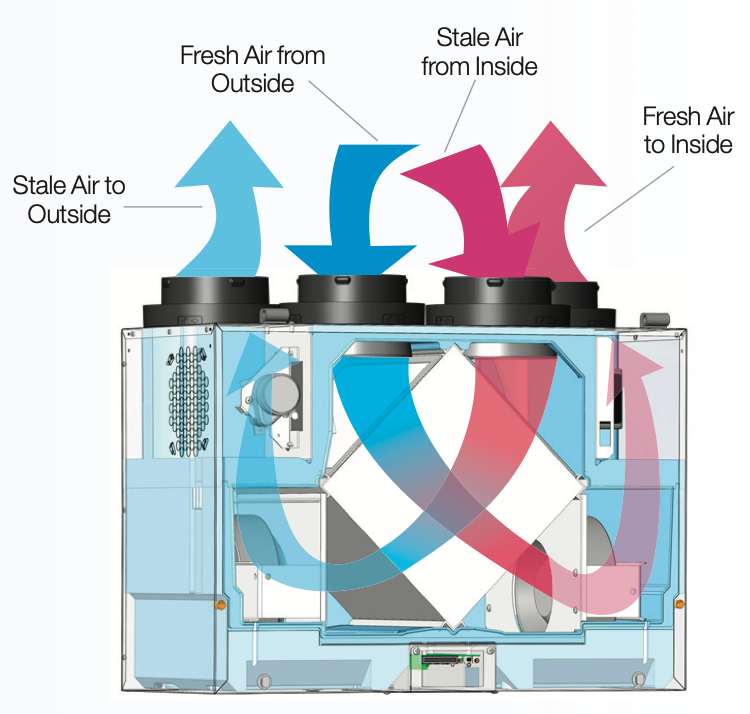Action Plan: What to Consider Before Choosing HRV
Exactly How Heat Recovery Ventilation Improves Indoor Air High Quality and Reduces Power Costs
Heat Recovery Ventilation (HRV) systems play a crucial duty in boosting interior air quality while at the same time reducing energy costs. By effectively trading stagnant indoor air with fresh outside air, HRVs help preserve optimal humidity and minimize toxins. In addition, their capacity to recover warmth from outbound air minimizes the strain on home heating and cooling systems. As power costs remain to rise, recognizing the complete capacity of HRV systems becomes increasingly crucial for property owners and businesses alike.
Comprehending Heat Recovery Ventilation Equipments

Heat recovery ventilation (HRV) systems play an essential role in enhancing indoor air top quality, specifically in contemporary, energy-efficient structures. These systems are developed to transfer warmth from the outward bound stale air to the incoming fresh air, therefore minimizing energy loss while preserving perfect temperature degrees indoors. HRVs contain a warmth exchanger, fans, and ductwork, assisting in the constant circulation of air. By getting rid of indoor contaminants and presenting fresh air, HRVs assist to balance moisture degrees, prevent mold and mildew development, and lower irritants. The efficiency of HRV systems hinges on their capability to recoup up to 80% of the warmth from the exhausted air, advertising power conservation while making certain a healthy interior atmosphere. Their combination is crucial in attaining lasting living methods.
The Relevance of Indoor Air High Quality
Indoor air quality (IAQ) is a critical element affecting the health and health of owners in any kind of environment. Poor IAQ can result in numerous wellness problems, including respiratory system troubles, allergies, and tiredness. Furthermore, it can intensify status quo such as asthma. Aspects adding to reduced IAQ consist of contaminants from indoor sources like cleaning agents, mold, and inadequate ventilation. Keeping excellent IAQ is essential for advertising a risk-free and comfy living or working space. Reliable approaches to boost IAQ include normal monitoring of air quality, correct ventilation systems, and lessening the usage of harmful compounds inside your home. By focusing on IAQ, individuals can ensure a much healthier environment that cultivates efficiency and total top quality of life.
Energy Effectiveness Conveniences of HRV Systems
Several property owners and building supervisors are progressively acknowledging the power efficiency benefits of heat recovery air flow (HRV) systems. By transferring heat from tired indoor air to inbound fresh air, HRV systems considerably decrease the power required for heating and cooling. This procedure decreases reliance on traditional cooling and heating systems, leading to lower energy bills. Furthermore, HRVs aid keep a balanced indoor climate, preventing too much home heating or cooling down needs. The capability to recover as much as 90% of the warm from outgoing air additionally supports sustainability initiatives by minimizing general energy usage. HRV systems contribute not only to cost savings yet likewise to a minimized carbon impact, aligning with the growing focus on energy-efficient building practices.
Installment and Upkeep Considerations
The reliable implementation of warm recovery air flow (HRV) systems needs cautious factor to consider of installment and upkeep factors to assure peak efficiency. Correct positioning of the HRV device is important, as it must be installed in an area that optimizes airflow while minimizing sound interruption. Furthermore, ductwork needs to be properly sized and insulated to stop energy loss. Regular maintenance, consisting of filter substitute and system cleansing, is important to protect optimum functionality and indoor have a peek at these guys air high quality. Owners must establish a regular upkeep timetable to determine and address prospective concerns prior to they rise. Collaboration with experienced specialists throughout both installment and upkeep phases can enhance the durability and efficiency of HRV systems, inevitably causing far better interior settings and wikipedia reference reduced power expenses.
Real-World Applications and Success Stories
Exploring real-world applications of warmth recuperation air flow (HRV) systems exposes their considerable influence on indoor air top quality and energy performance across various setups. In domestic buildings, homeowners have actually reported improved air top quality, causing fewer allergies and breathing issues. Schools applying HRV systems have actually kept in mind boosted pupil concentration and minimized absence as a result of far better air flow. Commercial structures, such as workplaces and retail areas, have experienced lower power expenses and raised employee productivity. As an example, a company office in a warm climate attained a 30% decrease in energy expenses after setting up an HRV system. These success tales show that HRV innovation not only adds to much healthier atmospheres but also provides concrete financial advantages, making it a useful investment for various sectors.
Regularly Asked Inquiries
Can HRV Systems Decrease Allergens in Indoor Air?
The efficiency of HRV systems in decreasing interior allergens primarily pivots on their ability to filter and exchange air. HRV Heat Recovery Ventilation. By continuously changing stale air, these systems can significantly decrease allergen degrees throughout interior atmospheres

How Does Humidity Affect HRV System Performance?
Humidity substantially influences HRV system performance; high levels can cause condensation, minimizing effectiveness, while reduced moisture might improve air exchange. Stabilizing humidity is vital for suitable operation and preserving interior air high quality.
Are HRV Equipments Noisy Throughout Operation?
HRV systems can produce varying sound levels throughout operation, relying on their style and installation. Some systems operate silently, while others may create obvious sound, particularly Bonuses at higher air flow settings or when improperly maintained.
What Is the Typical Lifespan of an HRV System?

Can HRV Solutions Be Made Use Of in All Environments?
HRV systems can be made use of in numerous environments, however their performance might differ - HRV Heat Recovery Ventilation. In severe temperature levels, modifications or extra systems may be needed to assure suitable efficiency and convenience while preserving interior air high quality